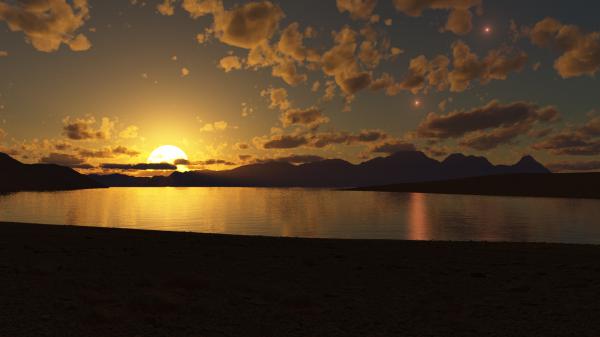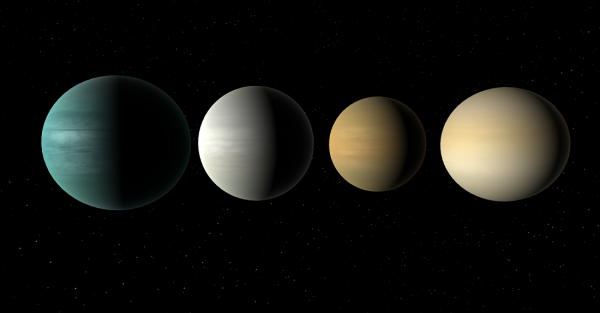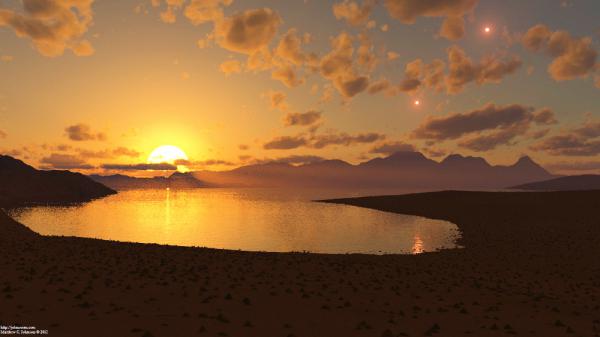BY LETTER
Gliese 667
Galactography > Regions of Space > Inner Sphere
Galactography > Systems and Worlds > Systems & Worlds G - H
Galactography > Systems and Worlds > Systems & Worlds G - H
A triple-star system in the Inner Sphere | |
 Image from Matthew C. Johnson | |
| The three stars of this system as seen from the surface of the tidally-locked SuperGaian Arcas | |
Gliese 667 - A Triple Star System in the Inner Sphere -Data Panel | |
| Gliese 667 A | Star Name: Gliese 667 A Physical characteristics: - Mass: 1.452E+30 kg (0.73 x Sol) - Radius: 528,732 km (0.76 x Sol) - Luminosity: 0.254 x Sol (bolometric) - Temperature: 4,700 Kelvin - Spectral type: K3V - Age: 6 billion years - Distance from Sol: 23.873 ly - This system has two dwarf planets, orbiting at 0.11 AU and 0.27 AU |
|---|---|
| Gliese 667 B | Name: Gliese 667 B Orbital characteristics: - Semi-major axis: 1,961,908,000 km (13.115 AU) - Period: 39.855 Julian years - Eccentricity: 0.58 Physical characteristics: - Mass: 1.372E30 kg (0.69 x Sol) - Radius: 486,990 km (0.70 x Sol) - Luminosity: 0.181 x Sol (bolometric) - Temperature: 4,500 Kelvin - Spectral type: K5V - Age: 6 billion years - This system has a single dwarf planet, orbiting at 0.3 AU |
| Gliese 667 c, Neojovia | Star Name: Gliese 667 C, Neojovia Orbital characteristics: - Semi-major axis: 33,000,000,000 km (220 AU) - Period: 2,467 Julian years Physical characteristics: - Mass: 6.562E29 kg (0.33 x Sol) - Radius: 222,624 km (0.32 x Sol) - Luminosity: 0.017 x Sol (bolometric) - Temperature: 3,700 Kelvin - Spectral type: M1.5V - Rotation period: 105 days - Age: 6 billion years |
 Image from Dangerous Safety | |
| The planets orbiting Gliese 667C | |
Planets of Gliese 667 C - The Neojovia System | |
| Leda | Orbital characteristics: - Semi-major axis: 7,540,000 km (0.050 AU) - Period: 7.194 days - Eccentricity: 0.122 Physical characteristics: - Type: Epistellar Pyrothalassic - Mass: 4.700E25 kg - Radius: 12,056.7 km - Density: 6,402 kg/m^3 - Gravitational acceleration: 21.579 m/s2 (2.200 g) - Rotation period: Tidally-locked - Albedo: 0.012 - Average surface temperature (1 bar): 1,800 K Atmosphere: - Surface pressure: 385 kPa - Composition: 58% H2, 39% He, 2% Ar, 1% other Satellites: none |
|---|---|
| Horvat | Orbital characteristics: - Semi-major axis: 18,700,000 km (0.125 AU) - Period: 28.1 days - Eccentricity: 0.133 Physical characteristics: - Type: Epistellar Pyrohydrothalassic. - Mass: 3.079E25 kg - Radius: 11,154.5 km - Density: 5,297 kg/m3 - Gravitational acceleration: 16.518 m/s2 (1.684 g) - Rotation period: Tidally-locked - Albedo: 0.574 - Average surface temperature (1 bar): 327 K Satellites: none |
| Arcas | Orbital characteristics: - Semi-major axis: 23,262,000 km (0.156 AU) - Period: 39.0 days - Eccentricity: 0.031 Physical characteristics: - Type: Vesperian SuperGaian (a tidally-locked Super-Earth) - Mass: 2.256E25 kg - Radius: 9,723.9 km - Density: 5,857 kg/m3 - Gravitational acceleration: 15.922 m/s2 (1.623 g) - Rotation period: Tidally-locked - Albedo: 0.371 - Average surface temperature: 307 K Atmosphere: - Surface pressure: 187 kPa - Composition: 84% N2, 10% O2, 3% Ne, 2% Ar, 1% other Satellites: none Lagrangian points: - L1: Magshield, used to regulate the planet's temperature and radiation environment |
| Nidaba | Orbital characteristics: - Semi-major axis: 31,760,000 km (0.212 AU) - Period: 62.2 days - Eccentricity: 0.052 Physical characteristics: - Type: SuperEuropan (large, icy world with a liquid sub-crustal ocean) - Mass: 2.228E25 kg - Radius: 10,270.6 km - Density: 4,910 kg/m3 - Gravitational acceleration: 14.099 m/s2 (1.437 g) - Rotation period: Tidally-locked (3:2 spin-orbit) - Albedo: 0.493 - Average surface temperature: 199 K Atmosphere: - Surface pressure: 11.4 kPa - Composition: 95% N2, 3% Ne, 1% Ar, 1% other Satellites: none |
History
The multiplanet system around Gliese 667C was detected early in the Information Age, and garnered interest with a superterrestrial located in the habitable zone. Follow-up observations indicated the planet, which became known as Arcas, was in fact lifeless. An unmanned interstellar probe to explore this system was launched in 505 AT. By the time the probe reached the system two centuries later SolSys was in the nadir of a Dark Age, leading to a failure of established live-man triggers and only the most preliminary data being relayed back.The system was colonized by Federationists in 1109 AT. Clan Yall allowed the Genen to establish a presence in the system early on. They preferred to concentrate on studying and designing aesthetically pleasing ecosystems that at the same time could survive without intervention. The tidally-locked supergaian Arcas and the hot-water-world Horvat were both the subject of ecopoesis, with very different results. Clan Yall's expertise in ecosystem building was instrumental in the creation of Neo-helix in the neighboring system; a fact they feel is often ignored when comparing the accomplishments of House Genen families.
The transition between the end of the First Federation and the rise of the megacorporations was a particularly difficult one for this system. Clan Yall experienced extensive in-fighting, that often spilt over into proxy wars involving client populations throughout Gliese 667. Waves of sectarian radicalization occurred, with anti-transapient and pro-anthropist sentiment becoming entrenched. The entire system became a backwater of sorts for the next millennium.
Gliese 667 returned to the galactic stage in 3901 when it was the chosen neutral site for a conference to negotiate an end to the Conver Wars. While this conference failed to meet the lofty goals set out for it, this initial conference did set the groundwork for the Ian Treaty of 3932. Both the Ambi Limis and the Geminga Orthodoxy remembered this humanitarian effort on behalf of their citizens and retained close ties to the system.
By the Age of Crisis most the larger moons had been set aside as nature reserves, and the population had shifted to exclusively living in orbitals or bubblehabs.
Numerous coalitions arose at this time, the largest being the colorfully named Confederation of the Million Floating Eyots. The current population in cosmopolitan in composition. Of note, the system supports large populations of Neanderthals, Grays, and Raffins.
 Image from Matthew C. Johnson | |
| The sky of Arcas, another view | |
Related Articles
Appears in Topics
Development Notes
Text by Mark Ryherd, updated by The Astronomer, 2019
Initially published on 21 May 2012.
Initially published on 21 May 2012.






